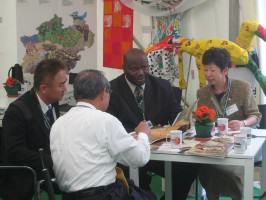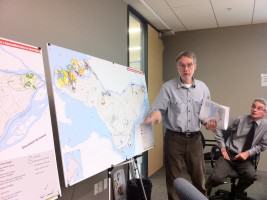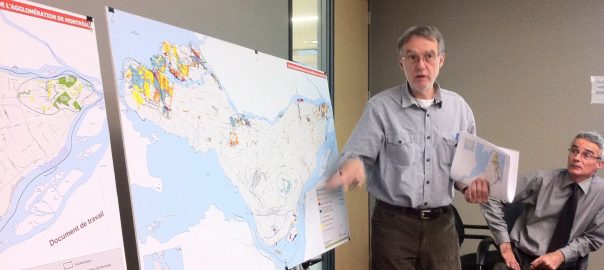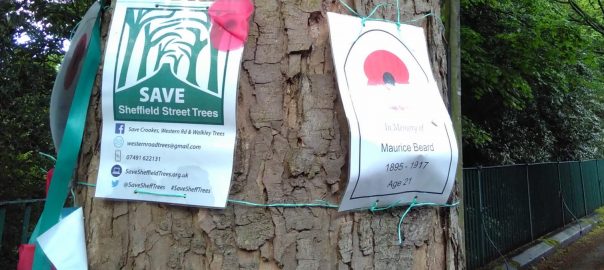One hundred ninety two national governments and the EU have signed the Convention on Biological Diversity (CBD), pledging to work towards its three objectives (see here). In reality, much of the onus falls on local governments although, often, neither level is aware of this nor how it should take place. In fact, local governments’ task is disproportionately important because their efforts can reach so many people in such relatively small spaces. An urban park, for example, can expect orders of magnitude more visitors per unit area than even the most popular national park. And it’s not just about the collective acreage of land. Access to nature where people live can affect their attitude towards nature in general – and this is manifested through their votes and other forms of support.
Much good work is being done by many dedicated individuals in this field. However, in most of the world’s cities management of biodiversity is given little consideration or priority. It is therefore up to the international community to set this right through initiatives to support those willing to take steps towards improvement. Unfortunately projects and programmes to address this often lack any true sense of continuity. Workshops present a common example: they are relatively easy to organize, convene and fund, and they allow a box to be ticked no matter what happens after everyone goes home. Even with longer-term projects it’s relatively easy to start something and then say “ok, now you take over”. What’s much more challenging is to ensure the sustainability of an initiative, especially if the beneficiaries weren’t consulted or involved in the conception of the idea. For local government officials, among others, this can be demoralizing in the long term. They may look to aid agencies, international organizations etc. with hope, but might receive little more than ideas and contact details – useful though these may (or may not) turn out to be.
I count myself among the guilty. I have been involved in a number of initiatives in which continuity has not been a central focus. I believe we, as “city biodiversity people”, need to be in this for the long haul. We need to figure out not what sounds good, but what is realistic; we need to figure it out in consultation with those who need to carry on with it; and we need to employ mechanisms that will increase the chances of them being able to do it. Here I’ll outline three mechanisms to which, I think, we need to pay more attention when working to support local governments: personality, politicians, and policy & planning.
Personality

One of the most striking mechanisms to achieve positive change that I have experienced in years of working with local governments has been “champions”. In many cases an individual’s ingenuity and determination can achieve more than even a considerable amount of funding. This is partly because such an individual will find ways to ensure that the broader workforce of the local government by which they are employed can be harnessed and mobilized to achieve many of the results for which they are aiming. Almost every local government department is affected by, and has an effect on, ecosystems through their work. If each of them is made aware and considerate of the need to conserve biodiversity, much more will be achieved than the biodiversity practitioner could dream of achieving alone – even with a huge budget. And in many cases all that is required is their will, not necessarily more work or more funding, but a different approach.
Champions’ position in the hierarchy is important in affecting this kind of cross-sectoral illumination and working together but more important, I think, is personality. I have encountered many individuals who have achieved success by virtue of who they are and how they relate to others. They are also determined, thick-skinned, strategic, proactive, and patient. For example, in a Canadian municipality the director of the city’s natural areas office has established good relationships with the mayor and directors of each of the city’s major divisions so that all are now prepared to listen when biodiversity is brought up; he has increased local decision-making autonomy from the provincial level; and he has been at the centre of the development of numerous new and innovative projects. He has established his city as a known world leader through their involvement in global initiatives like ICLEI’s Local Action for Biodiversity (LAB) Programme, thereby effectively advertising and thus bolstering the work already done by his city. He is a source of inspiration for many with whom he has come into contact.
Recommendation: Identify champions so that their lessons can be shared and their actions further supported; and identify those who have the potential to fill this role, empowering them to act in their own municipalities by showing them what’s been done; how to do it; and that they are not alone in their endeavor.
Politicians
 While a biodiversity practitioner’s effect is limited to some extent by their position, a politician is constrained more by their need to address a number of often-conflicting issues, and to satisfy their constituency. This also has quite a lot to do with personality but it’s more about awareness and subsequent willingness. If politicians have the will to support biodiversity, biodiversity practitioners are likely to be given considerable freedom in their work and, just as importantly, more likely to be able to access municipal funding. On the other hand if a politician has taken a stance in opposition to biodiversity, for example if they consider it to do nothing but impede development, then very little will be achieved by even a well-staffed and well-integrated biodiversity unit. Even the neutral politician can be restrictive because, when biodiversity comes up against other priorities, the likelihood is that this decision-maker will know and care more about a new road or housing development than about a concept with which they are less familiar.
While a biodiversity practitioner’s effect is limited to some extent by their position, a politician is constrained more by their need to address a number of often-conflicting issues, and to satisfy their constituency. This also has quite a lot to do with personality but it’s more about awareness and subsequent willingness. If politicians have the will to support biodiversity, biodiversity practitioners are likely to be given considerable freedom in their work and, just as importantly, more likely to be able to access municipal funding. On the other hand if a politician has taken a stance in opposition to biodiversity, for example if they consider it to do nothing but impede development, then very little will be achieved by even a well-staffed and well-integrated biodiversity unit. Even the neutral politician can be restrictive because, when biodiversity comes up against other priorities, the likelihood is that this decision-maker will know and care more about a new road or housing development than about a concept with which they are less familiar.
In my work I have encountered fewer politicians who are really moving biodiversity work than practitioners. In some cases, however, a politician has really made things happen. One Australian mayor has made his relatively small and previously unknown city stand out globally by associating himself with biodiversity issues. It is unlikely to be a coincidence that he is also the president of his state’s local government association; member of the executive committee of the world’s largest local government organization dedicated to environmental sustainability; and that his city is regarded among the leaders in local biodiversity conservation worldwide.
Recommendation: Build relationships with politicians, and between them and their biodiversity staff, and raise awareness on how the support of ecosystem services can be used to support their position and campaign (remember politicians are always on campaign).
Policies and plans
 The problem with both personalities and politicians is impermanence. While both represent very worthwhile mechanisms for maintaining a focus on biodiversity considerations, they do unfortunately come and go. This is especially true for the latter and necessitates a constant process of relationship-building which can be especially tricky when a new administration abhors the old, and may even get rid of officials associated with it. As an additional and supporting measure policy is, therefore, critical. It, too, can be changed over time depending on the administration but can provide an additional safeguard. Even if a new administration is bent on changing or removing it, the due process required may at least buy some time to win them over.
The problem with both personalities and politicians is impermanence. While both represent very worthwhile mechanisms for maintaining a focus on biodiversity considerations, they do unfortunately come and go. This is especially true for the latter and necessitates a constant process of relationship-building which can be especially tricky when a new administration abhors the old, and may even get rid of officials associated with it. As an additional and supporting measure policy is, therefore, critical. It, too, can be changed over time depending on the administration but can provide an additional safeguard. Even if a new administration is bent on changing or removing it, the due process required may at least buy some time to win them over.
Both policy and the plans that flow from them need, however, to be timed and placed strategically. For example a recent study (Radeloff et al. 2012) of 35 countries worldwide showed that the promulgation of protected areas tended to occur in spates rather than gradually over time. 44% of the countries studied “protected more than half of their protected area in one year, and 61% did so in one 5-year period”. The authors concluded that conservationists need to account for these ‘hot moments’ in countries’ political progression, which “often coincided with societal upheaval such as the collapse of the USSR or the end of colonialism”, in order to be most effective.
Placement is equally important. Consider, for example, the case of a medium-sized city in which a biodiversity action plan is one of about 50 sectoral plans. Although it guides the biodievrsity unit responsible, it cannot be expected to influence 49 other sectoral plans. The rather simple and elegant solution was to ensure that the key principles of the biodiversity plan were integrated into one of the city’s overarching plans, which must be followed by each sector and appropriately reflected in their sectoral plans. Again, timing is also important because there is a limited period during which plans can be revised.
Recommendation: Encourage biodiversity practitioners in local government to consider their contribution to policy and plans to be a strategic component of their duties that will pave the way for their on-the-ground work.
Parting words
The mandate of the United Nations, as its name suggests, is to serve the national governments of the world. The message that I am trying, with others like my supervisor, Oliver Hillel and colleagues from ICLEI, to get across is that they are the ones only who start things. National Biodiversity Strategies and Action Plans (NBSAPs) are a requirement of each Party to the Convention but, in reality, the “A” and “P” parts of the acronym can be specific enough to result in implementation only once the plan is applied and specified at the local level. A 2010 report on progress with NBSAPs by the United Nations University confirms that “the overall NBSAP will only be implemented if corresponding strategies and action plans are also developed and implemented at the relevant sub-national level(s)”.
And yet there remains a huge gap between national strategy, and local planning and implementation. Who best to do this than the local arms of the same national governments?
There is much work to be done but implementing mechanisms at the local level, while simultaneously working to raise awareness at national and international level to increase support for what happens locally seems a good way to go.
André Mader
Montreal







Leave a Reply